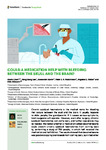Could a Medication Help With Bleeding Between the Skull and the Brain?
| dc.contributor.author | Chari, A | |
| dc.contributor.author | Lee, KS | |
| dc.contributor.author | Alamri, A | |
| dc.contributor.author | Hutchinson, PJA | |
| dc.contributor.author | Kolias, AG | |
| dc.contributor.author | Edlmann, Ellie | |
| dc.date.accessioned | 2022-10-28T13:02:21Z | |
| dc.date.available | 2022-10-28T13:02:21Z | |
| dc.date.issued | 2022-10-03 | |
| dc.identifier.issn | 2296-6846 | |
| dc.identifier.issn | 2296-6846 | |
| dc.identifier.other | 789786 | |
| dc.identifier.uri | http://hdl.handle.net/10026.1/19778 | |
| dc.description.abstract |
<jats:p>Chronic subdural haematoma is the medical name for bleeding that occurs between the skull and the brain. It usually happens to older people, like grandparents. If it causes serious symptoms, brain surgeons will operate. However, even after surgery, chronic subdural haematomas can come back, and further operations may be needed. We tested whether a medication called dexamethasone could prevent chronic subdural haematomas from coming back by performing a study of 750 people, in which half received the medication and half did not. The results showed that dexamethasone was good at stopping brain bleeds from coming back, but it had other effects that caused patients to have a more difficult recovery than did those who did not take it. These results are really important to stop doctors from giving this medication—it shows that, at the moment, surgery alone is the best treatment.</jats:p> | |
| dc.format.extent | 789786- | |
| dc.language.iso | en | |
| dc.publisher | Frontiers Media | |
| dc.subject | Brain Disorders | |
| dc.subject | Patient Safety | |
| dc.subject | Neurosciences | |
| dc.subject | Neurodegenerative | |
| dc.subject | Neurological | |
| dc.title | Could a Medication Help With Bleeding Between the Skull and the Brain? | |
| dc.type | journal-article | |
| plymouth.volume | 10 | |
| plymouth.publication-status | Published online | |
| plymouth.journal | Frontiers for Young Minds | |
| dc.identifier.doi | 10.3389/frym.2022.789786 | |
| plymouth.organisational-group | /Plymouth | |
| plymouth.organisational-group | /Plymouth/Faculty of Health | |
| plymouth.organisational-group | /Plymouth/Faculty of Health/Peninsula Medical School | |
| plymouth.organisational-group | /Plymouth/REF 2021 Researchers by UoA | |
| plymouth.organisational-group | /Plymouth/REF 2021 Researchers by UoA/UoA01 Clinical Medicine | |
| plymouth.organisational-group | /Plymouth/Research Groups | |
| plymouth.organisational-group | /Plymouth/Research Groups/FoH - Applied Parkinson's Research | |
| plymouth.organisational-group | /Plymouth/Research Groups/Plymouth Institute of Health and Care Research (PIHR) | |
| plymouth.organisational-group | /Plymouth/Users by role | |
| plymouth.organisational-group | /Plymouth/Users by role/Academics | |
| plymouth.organisational-group | /Plymouth/Users by role/Researchers in ResearchFish submission | |
| dcterms.dateAccepted | 2022-09-15 | |
| dc.rights.embargodate | 2022-10-29 | |
| dc.identifier.eissn | 2296-6846 | |
| dc.rights.embargoperiod | Not known | |
| rioxxterms.versionofrecord | 10.3389/frym.2022.789786 | |
| rioxxterms.licenseref.uri | http://www.rioxx.net/licenses/all-rights-reserved | |
| rioxxterms.type | Journal Article/Review |


